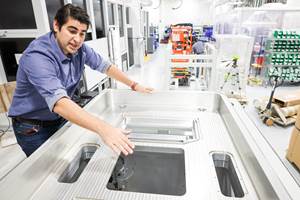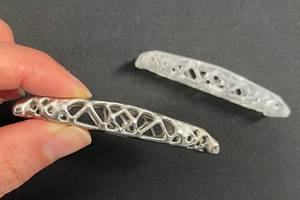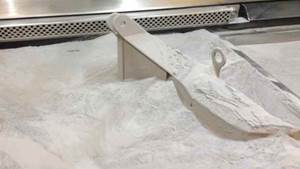Will My AM Part Explode?
Will my additive manufactured part explode? Not if you’re careful. Postprocessing parts built from metallic powder requires extra precautions.
When you are machining a part, how often do you worry about that part exploding? Probably not very often if you are working with parts made through conventional manufacturing processes (casting, forging and so on). With additively manufactured parts, however, this could be an issue.
Among the more serious issues related to additive manufacturing are safety concerns related to parts built using metallic powder feedstock, particularly during postprocessing of those parts.
Perhaps you have seen images of operators and technicians in respirators and personal protection equipment as they remove parts from a laser-based powder-bed fusion system. This is because the metallic powder feedstock used in this type of metal AM system is typically small enough to be inhaled and absorbed into the human body. While some of us may be a little iron-deficient, the last thing our bodies need is titanium, aluminum, nickel or some other heavy metal floating around in our bloodstreams. In fact, some people have sensitivity to nickel, and this limits the use of several metallic alloys for medical devices and implants.
What most people also fail to realize is that once the additively made part is removed from the build chamber and cleaned, it still is likely to contain trace amounts of powder feedstock. Because even though the metal part is fully dense, its support structures likely are not. Most support structures are hollow, and therefore powder can become trapped inside (see image above). Those support structures become exposed at one end when the part is removed from the build plate, releasing the trapped powder in the atmosphere. This is why submerged-wire EDM often is recommended for build-plate removal, allowing any loose powder to be captured and removed by the water. This practice may cause additional wear-and-tear on the machine, but at least it minimizes the release of powder into the work atmosphere.
It behooves us to talk to related industries that routinely use powder metal feedstock in their manufacturing processes to see how they handle and safely work with these materials.
If EDM is not used to remove the AM part from the build plate, secondary cleaning operations such as vacuuming will be needed to remove loose powder trapped in the support structures. This is not as easy as it may sound, however, as powder particles can adhere to the inside walls of the supports or be partially melted to the surface during stress relief. I cannot tell you how many times I have taken an AM part with its supports and banged it on a table only to have more powder fall away. Obviously, this is not a very sophisticated or reliable way to clean loose powder from a part. More research is needed to better understand how finishing techniques like soda blasting, abrasive-flow machining and electrochemical polishing can be used to help remove loose powder from inside support structures. In the meantime, AM users may want to consider using solid (non-hollow) supports for parts that will require a lot of
post-process machining and finishing.
This is because, in addition to being dangerous if inhaled, some metallic powder feedstocks like titanium and aluminum are pyrophoric, which means they can explode. So machining professionals need to be careful when finishing parts built from these materials; trapped powder may be released into the machine environment, and a spark or other combination of conditions could lead to an explosion. Extra caution should be used in handling and postprocessing these parts, first making sure that they have been properly cleaned. If any loose powder falls when the part is handled, it is not ready for machining.
During machining, using ample lubricant will help carry away loose powder and minimize the risk of inhalation or sparking. Shops may want to also install high-end filters on their machining centers to help capture these particle, as they are a lot smaller than the metal chips and pieces that are usually filtered out of the used lubricant stream.
The science to fully understand and diagnose the safety hazards associated with AM is still emerging, and fire marshals and local inspection/regulatory agencies are not yet prepared to deal with them either. It behooves us to talk to related industries that routinely use powder metal feedstock in their manufacturing processes to see how they handle and safely work with these materials. In the meantime, AM users need to know what material is being handled, take extra care to make sure that loose powder has been cleaned from parts before machining and make sure to use plenty of lubricant during machining. The last thing we need is for an AM part to explode on a mill or lathe as it is being finished; that would not be good for the operator, the company or the AM industry. So, be careful!
This article originally appeared in Additive Insights, a monthly column in Modern Machine Shop magazine.
Related Content
3D Printed Cutting Tool for Large Transmission Part: The Cool Parts Show Bonus
A boring tool that was once 30 kg challenged the performance of the machining center using it. The replacement tool is 11.5 kg, and more efficient as well, thanks to generative design.
Read MoreSeurat: Speed Is How AM Competes Against Machining, Casting, Forging
“We don’t ask for DFAM first,” says CEO. A new Boston-area additive manufacturing factory will deliver high-volume metal part production at unit costs beating conventional processes.
Read MorePossibilities From Electroplating 3D Printed Plastic Parts
Adding layers of nickel or copper to 3D printed polymer can impart desired properties such as electrical conductivity, EMI shielding, abrasion resistance and improved strength — approaching and even exceeding 3D printed metal, according to RePliForm.
Read MorePostprocessing Steps and Costs for Metal 3D Printing
When your metal part is done 3D printing, you just pull it out of the machine and start using it, right? Not exactly.
Read MoreRead Next
Alquist 3D Looks Toward a Carbon-Sequestering Future with 3D Printed Infrastructure
The Colorado startup aims to reduce the carbon footprint of new buildings, homes and city infrastructure with robotic 3D printing and a specialized geopolymer material.
Read MorePostprocessing Steps and Costs for Metal 3D Printing
When your metal part is done 3D printing, you just pull it out of the machine and start using it, right? Not exactly.
Read More3D Printed Polymer EOAT Increases Safety of Cobots
Contract manufacturer Anubis 3D applies polymer 3D printing processes to manufacture cobot tooling that is lightweight, smooth and safer for human interaction.
Read More





















